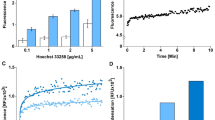Synopsis
Nuclei were isolated from mouse liver and central nervous system (CNS). These nuclei were fluorochromed without fixation in a 0.25m sucrose medium containing 5.5×10−5 m Acridine Orange and measured with an incident microfluorometric system. In the case of mouse CNS nuclei, the major and minor axes of the nuclei were measured with a filar micrometer. Three modal values were obtained from the hepatocyte suspension corresponding to 2C, 4C, and 8C nuclei, respectively. While the CNS nuclei displayed substantial variability in size, the Acridine Orange emission values at 530 nm were nearly constant. The data suggest that under these conditions, Acridine Orange fluorescence reflects DNA content. Further, the 530 nm fluorescence emission is not affected by chromatin condensation or proteins complexed with DNA.
Similar content being viewed by others
References
Alvarez, M. R. (1975). Microfluorometric comparisons of heat-induced nuclear acridine orange metachromasia between normal cells and neoplastic cells from primary tumors of diverse origin.Cancer Res. 35, 93–8.
Rolund, L., Debault, L. E., Foley, G. E., Gharton, G., Killander, D., Maloney, W. C., Rigler, R., Sakarin, A. &Wahren, B. (1972). Influence of cell density on acridine orange binding to deoxyribonucleoprotein complex in leucocytes from patients with infectious mononucleosis and acute leukemia.Acta Haemat. 48, 227–33.
Cowden, R. R. &Curtis, S. K. (1974). Acridine orange as a supravital fluorochrome indicating varying degrees of chromatin condensation.Histochemistry 40, 305–10.
Frenster, J. H. (1971). Electron microscopic localization of acridine orange binding to DNA within human leukemic bone marrow cells.Cancer Res. 31, 1128–33.
Frenster, J. H. &Herstein, P. R. (1973). Gene de-repression.New Engl. J. Med. 288, 1224–9.
Frenster, J. H., Nakatsu, S. L. &Masek, M. A. (1974). Ultrastructural probes of DNA templates within human bone marrow and lymph node cells. In:Advances in Cell and Modecular Biology, Vol. 3 (ed. E. J. DuPraw), pp. 1–19. New York: Academic Press.
Hymer, W. C. &Kuff, E. L. (1964). Isolation of nuclei from mammalian tissues through the use of Triton X-100.J. Histochem. Cytochem. 12, 659–63.
Liedeman, R. R., Matveyeva, N. P., Vostricova, S. A. &Prilipko, L. L. (1975). Extrinsic factors affecting the binding of acridine orange to the DNP complex of cell nuclei in different physiological states.Expl. Cell Res. 90, 105–10.
Rigler, R. (1966). Microfluorometric characterization of intracellular nucleic acids and nucleo-proteins by acridine orange.Acta physiol. scand. 67, Suppl. 267.
Ringertz, N. R. (1969). Cytochemical properties of nuclear proteins and deoxribonucleoprotein complexes in relation to nuclear function. In:Handbook of Molecular Cytology (ed. A. Lime-De-Faria), pp. 656–84. New York: American Elsevier.
Weisblum, B. (1974). Fluorescent probes of chromosomal DNA structure: Three classes of acridines.Cold Spring Harbor Symp. Quant. Biol. 38, 441–9.
West, S. S. &Lorincz, A. E. (1973). Fluorescent molecular probes in fluorescence microspectrophotometry and microspectropolarimetry. In:Fluorescence Techniques in Cell Biology (eds. A. A. Thaer & M. Sernetz), pp. 355–68. Berlin-Heidelberg-New York: Springer Verlag.
Author information
Authors and Affiliations
Rights and permissions
About this article
Cite this article
Cowden, R.R., Curtis, S.K. Some quantitative aspects of Acridine Orange fluorescence in unfixed, sucrose-isolated mammalian nuclei. Histochem J 8, 45–49 (1976). https://doi.org/10.1007/BF01004004
Received:
Issue Date:
DOI: https://doi.org/10.1007/BF01004004




